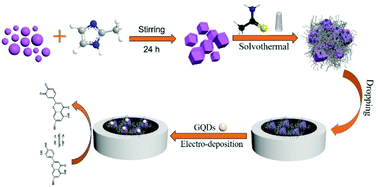An ultrasensitive luteolin electrochemical sensor based on a glass carbon electrode modified using multi-walled carbon nanotube-supported hollow cobalt sulfide (CoSx) polyhedron/graphene quantum dot composites†
Abstract
Luteolin (LU), belonging to the group of flavonoids with rich biological activities, has attracted considerable attention. Herein, a novel ultrasensitive LU electrochemical sensor based on hollow cobalt sulfide polyhedron–multi-walled carbon nanotube nanocomposites (CoSx–MWCNTs) and graphene quantum dots (GQDs) was proposed. The hollow CoSx polyhedrons derived from ZIF-67 showed excellent electrochemical sensing performance, which was attributed to the abundant surface active sites endowed by the special hollow structure. When detecting LU using the DPV model, the CoSx–MWCNTs/GQDs/GCE showed a linear range of 5 nM–2000 nM under optimal conditions, and the corresponding detection limit (LOD) was 1.2 nM (S/N = 3). In addition, the sensor exhibited satisfactory sensitivity and accuracy for detecting LU in real samples from Chrysanthemum extracts.



 Please wait while we load your content...
Please wait while we load your content...